Botswana and Namibia share a long, weirdly straight border, cutting like a knife through the arid desert landscape. In the north, an odd narrow finger of Namibia, once known as the Caprivi Strip and now called the Zambezi Region, juts out over the top of its neighbour.
Despite being neighbours and sharing the Kalahari Desert, the two countries are more different than the same.
When it comes to safari in Namibia and Botswana, both are Big Five destinations and have some of the wildest, most remote parks in Africa, and some of the most untamed landscapes in the world.
Botswana offers a more traditional, luxurious, and wildlife-dense safari experience with a focus on water-based activities, particularly in the Okavango Delta. Namibia provides a more affordable, adventurous experience with diverse desert landscapes and unique, desert-adapted wildlife.
What Is Botswana Known For?
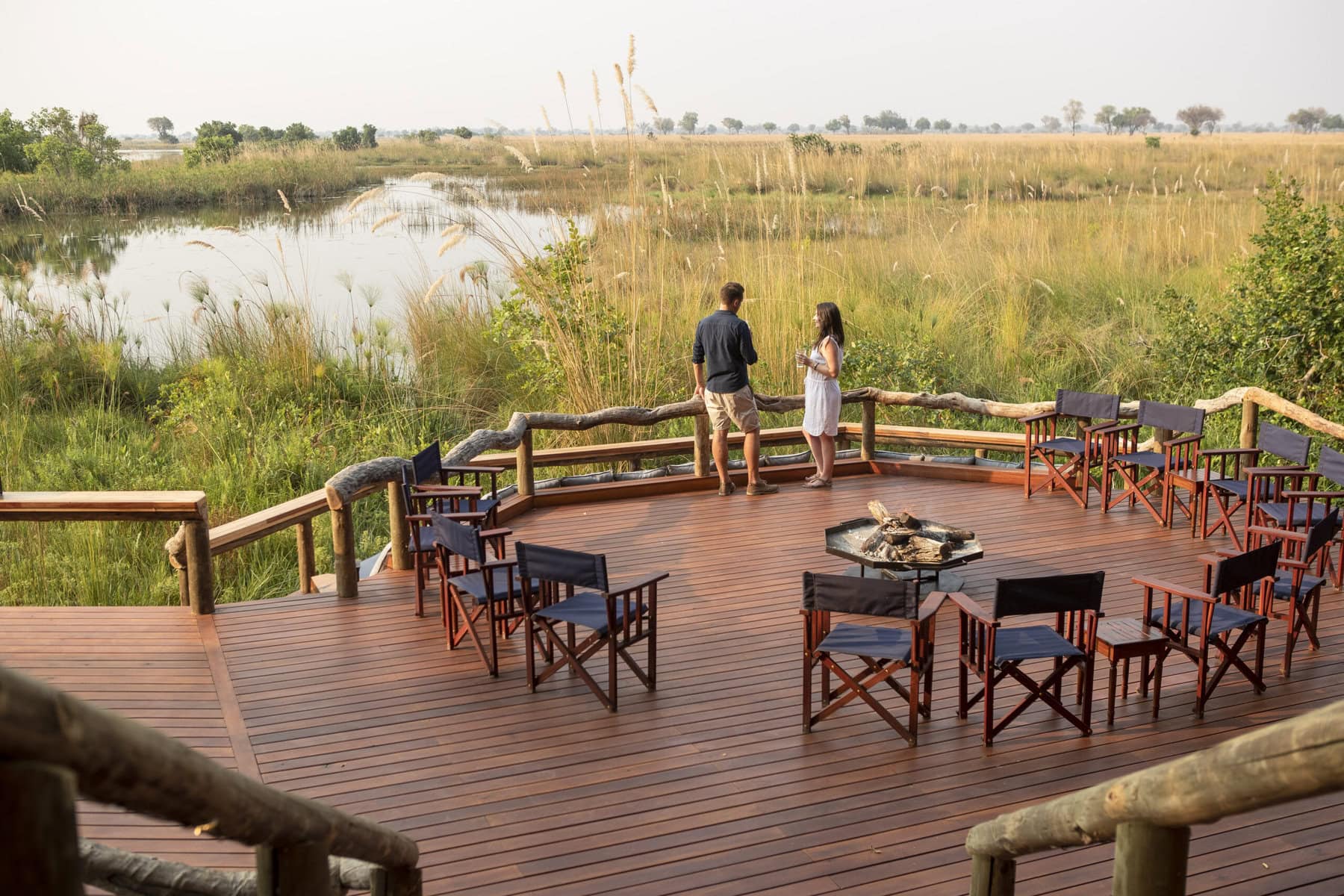
Botswana has a low-impact, high-value tourism model, and visitor numbers are deliberately limited to ease pressure on land and wildlife.
It’s known for its more luxury offerings, with fly-in safaris the norm, exclusive lodges and camps, and fewer crowds.
Botswana’s famous region is the Okavango Delta, a UNESCO World Heritage Site frequented by the world’s best wildlife filmmakers and countless travellers. It’s an extraordinary inland Delta where a river melts into the desert. This is what Botswana is known for.
Yet the country is still mostly arid, though not as arid as Namibia, and is covered almost entirely by the Kalahari Desert. It’s so huge, it has three game reserves: Central Kalahari Game Reserve, Kgalagadi Transfrontier Park, and Khutse Game Reserve.
Botswana is also home to the largest elephant population in the world, and herds hundreds strong throng Chobe National Park and the Okavango Delta. It also hosts one of Africa’s great annual mammal migrations, when about 25,000 zebras follow the water through the extraordinary Makgadikgadi Pans. The seasonal transformation of Makgadikgadi and Nxai pans is a magnet for wildlife.
When it comes to safaris, both countries boast some of the finest game viewing in all of Africa – and so the debate of Botswana vs Namibia often comes down to the style of safari you prefer.
Okavango Delta Wildlife
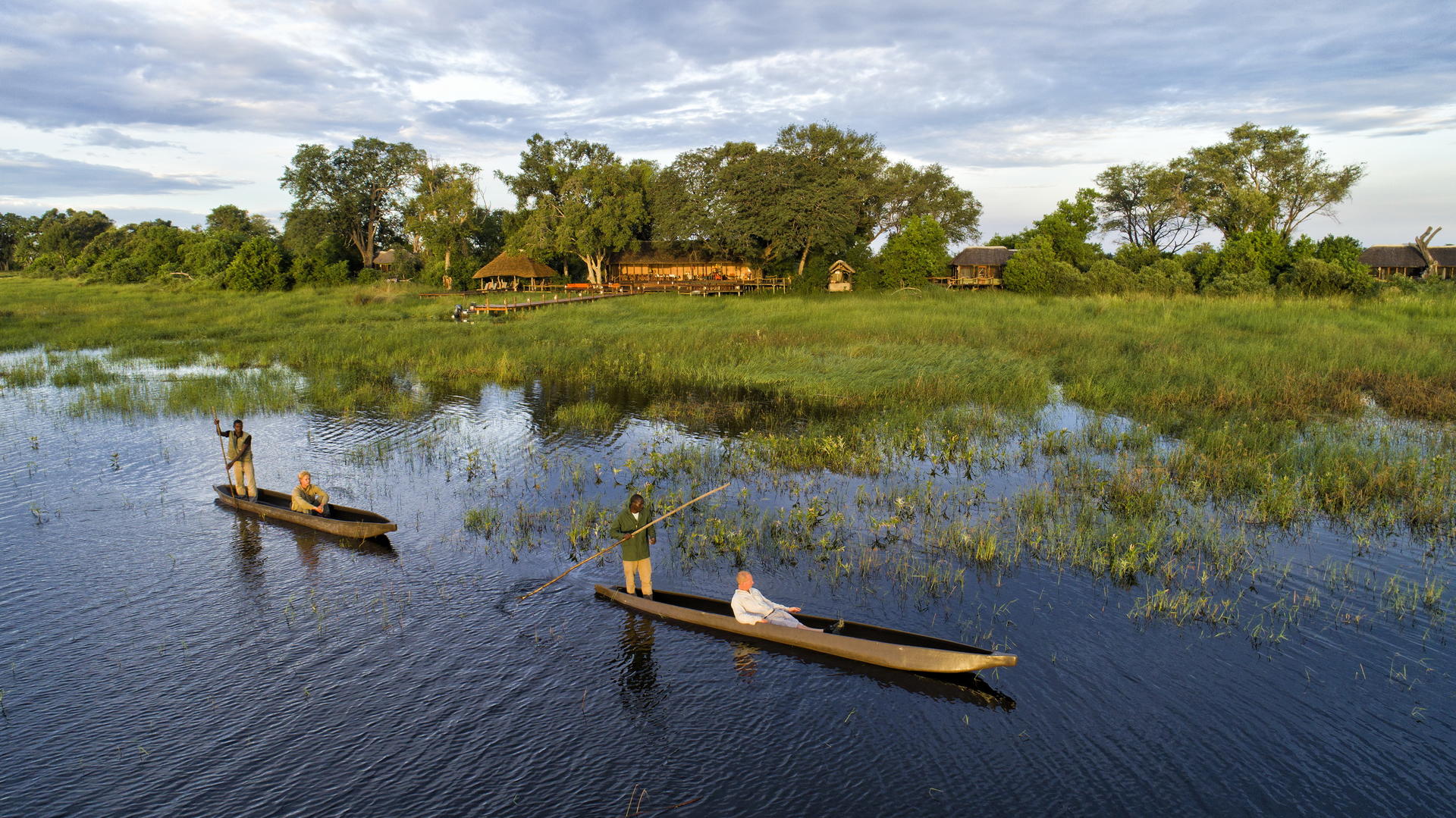
The Okavango Delta is an exclusive experience, with only fly-in access to many lodges. It’s known for its seasonal flooding, when it transforms into a lush oasis during the dry season, attracting large herds of elephants, buffaloes, and various predators.
In the wet season, the floodplains and channels attract huge flocks of migrating birds.
Antelope include rare swamp-dwelling sitatunga with their white markings, both spots and stripes, and red lechwe, which have long, splayed hooves adapted to navigating marshes.
Botswana’s water-based safaris and low-impact tourism policies emphasise preservation and seclusion, creating a more intimate connection with nature.
Luxury Safari Lodges
The high-value, low-volume model translates to primarily exclusive, high-end, low-impact tourism with fewer crowds. Safaris are often fly-in, using private lodges in remote areas. Game drives are with expert licensed guides, usually working in tandem with highly skilled trackers.
Mokoro Canoe Experiences
A mokoro is a traditional southern African canoe, and a ride on one is an extraordinary way to see the world – quiet, peaceful, the only sound the soft splash of the guide’s pole, or nkashi. You sit just a few centimetres above the water, giving an entirely different perspective to your safari.
Traditionally, mekoro (the plural) are dug out from the trunks of trees, such as ebony or kigelia (sausage tree). But this is not sustainable and mekoro today are generally made from fibreglass.
What Is Namibia Known For?
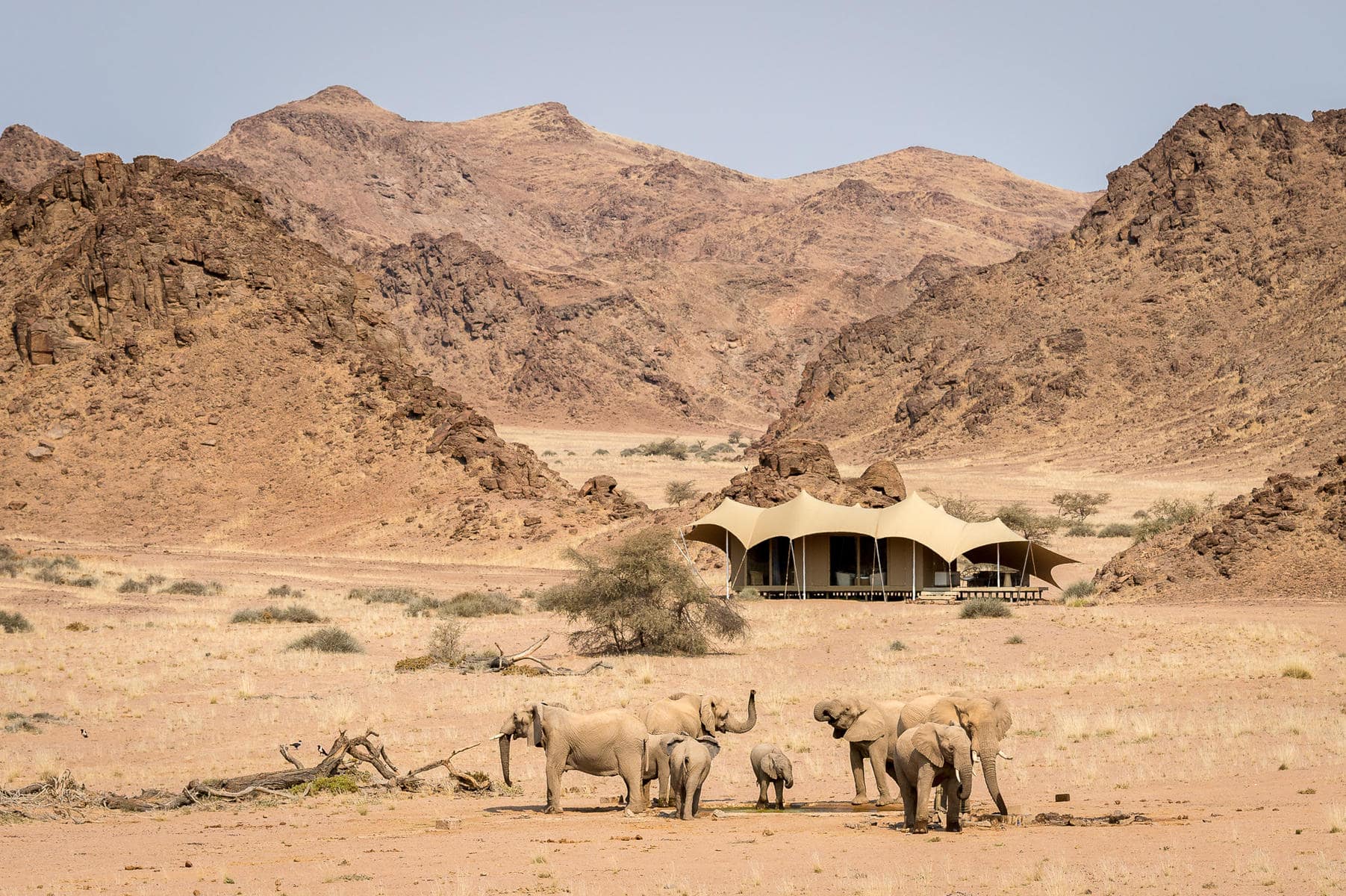
Namibia is all about dramatic landscapes, characterised by desert scenery, including the towering sand dunes of Sossusvlei, the haunting beauty of the Skeleton Coast, and the solitude of the immense Namib-Naukluft National Park.
The question, “what is Namibia known for?”, is often answered with its vast desert and unique coastline. Its namesake desert, the Namib, is the oldest desert in the world.
It’s the perfect wild and untouched country for adventures, with diverse desert landscapes and unique desert-adapted wildlife. Activities include horse riding safaris, hot-air balloon safaris, exploring Deadvlei, 4×4 excursions, guided beach walks, stargazing in the NamibRand Nature Reserve, and hiking – or just viewing – the Fish River Canyon, the second largest canyon in the world.
Etosha National Park is excellent for game viewing, particularly around waterholes during the dry season (May to October), where you can spot desert-adapted elephants, lions, giraffes, zebras, and more.
Sossusvlei Sand Dunes
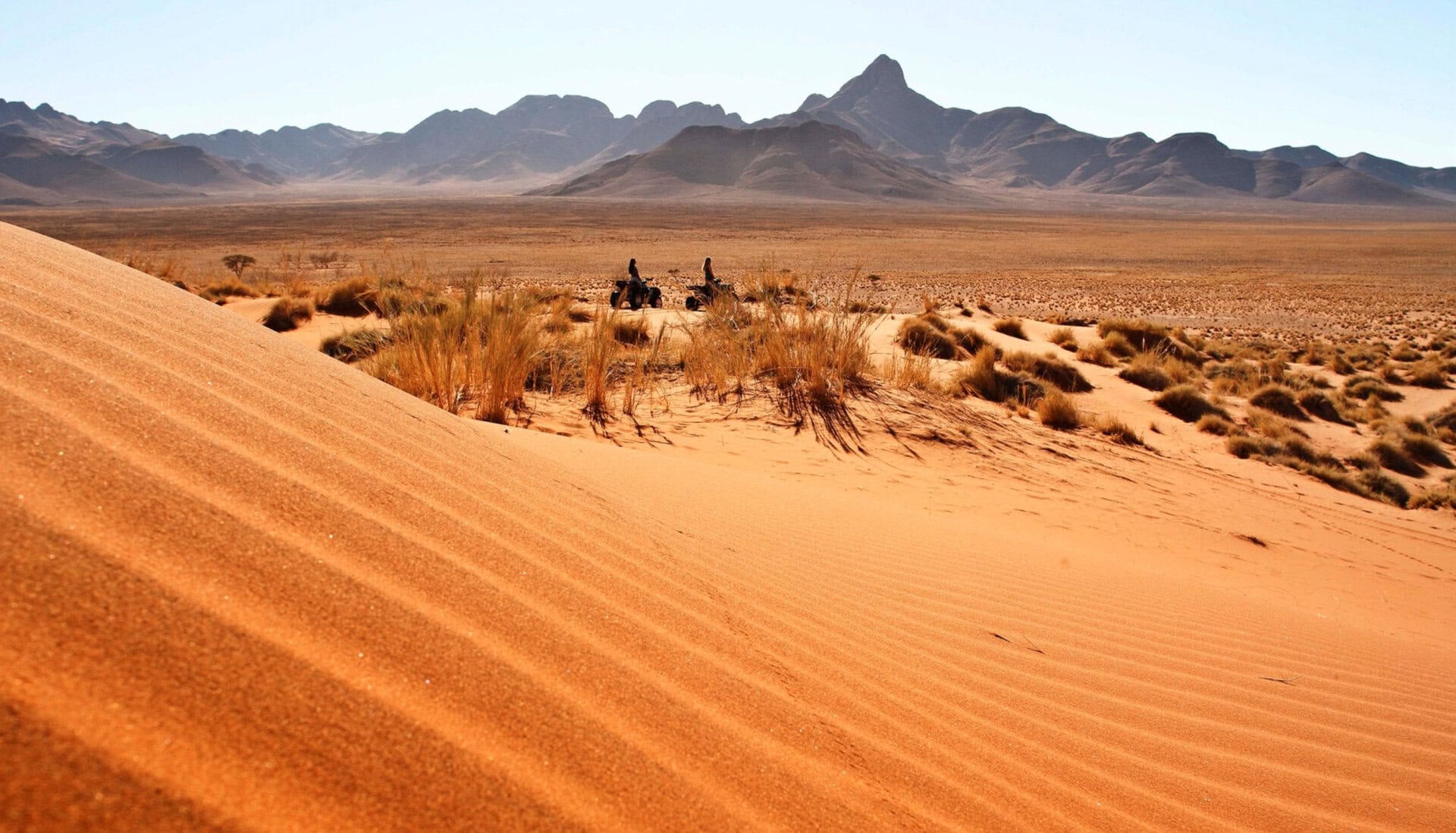
The Sossusvlei sand dunes are some of the tallest in the world, reaching more than 300 m into the air. They are vibrant reddish-orange in colour, the result of iron oxidation in the sand. And strong desert winds continually sculpt them into ever-changing ridges, peaks, and valleys.
Sossusvlei is in Namib-Naukluft National Park, creating a surreal, otherworldly landscape that glows beautifully at dawn and dusk. The dunes surround salt and clay pans that fill with water only after rare, heavy rains, but most of the time, they are bone-dry and appear white.
Nearby Deadvlei is one such pan, famous for its stunning petrified trees surrounded by the red dunes, left behind when the water source dried up, creating a stark photographer’s paradise.
Skeleton Coast Adventures
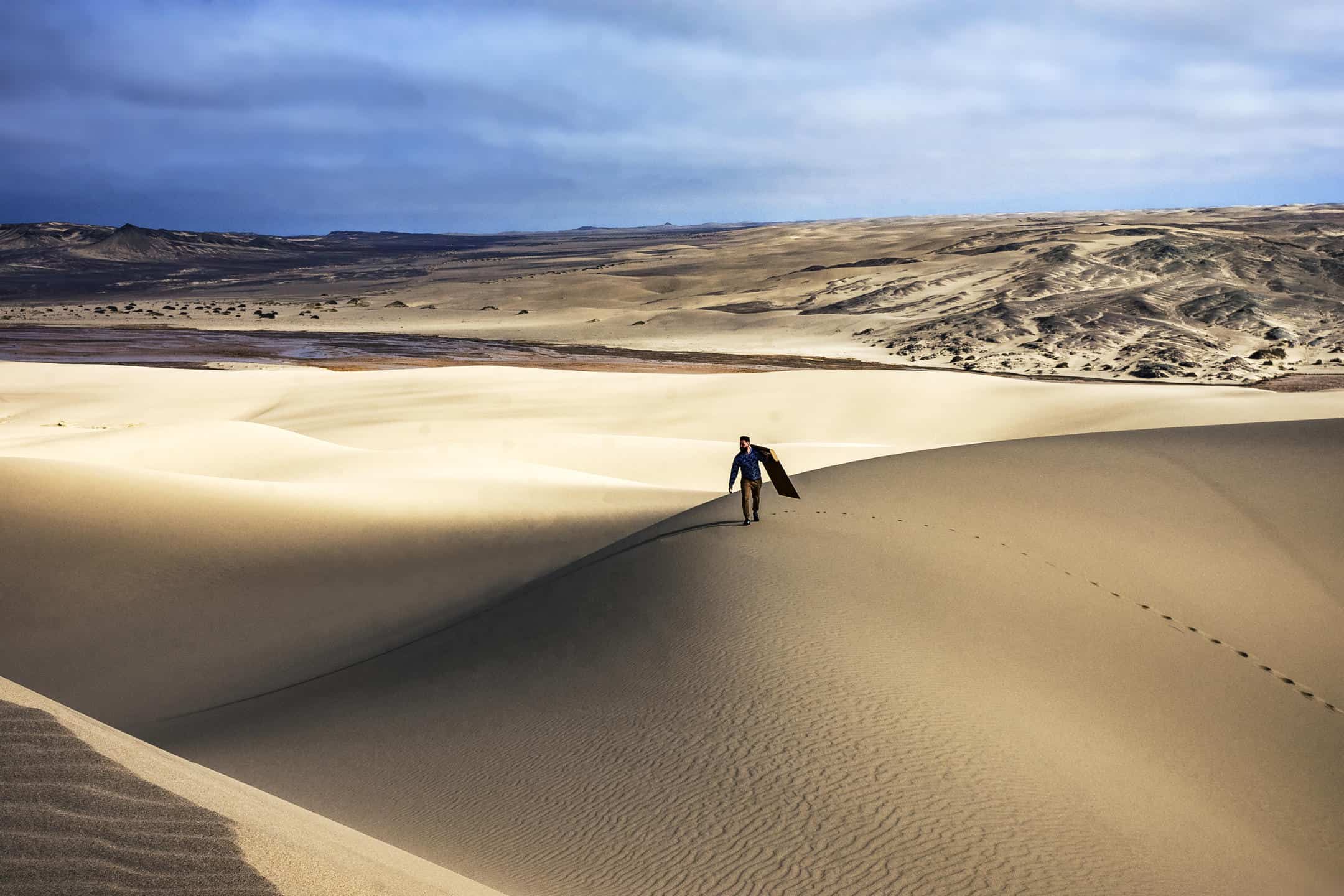
The Skeleton Coast has a harsh beauty – desert landscapes meeting the turbulent Atlantic Ocean. It’s littered with the numerous shipwrecks and whale bones that give it its name.
It’s remote, rugged and unique. There are sand dunes, canyons, volcanic rock, and rocky mountain outcrops.
Limited permits are available, making it possible to have vast areas to yourself. Take a scenic desert flight, climb a sand dune, go on game drives, go beachcombing for shipwrecks and bones, and explore the geologically remarkable Clay Castles along the Hoarusib River.
Further inland, you can visit authentic Himba villages and meet the Himba people who have lived here for centuries.
Desert-Adapted Wildlife
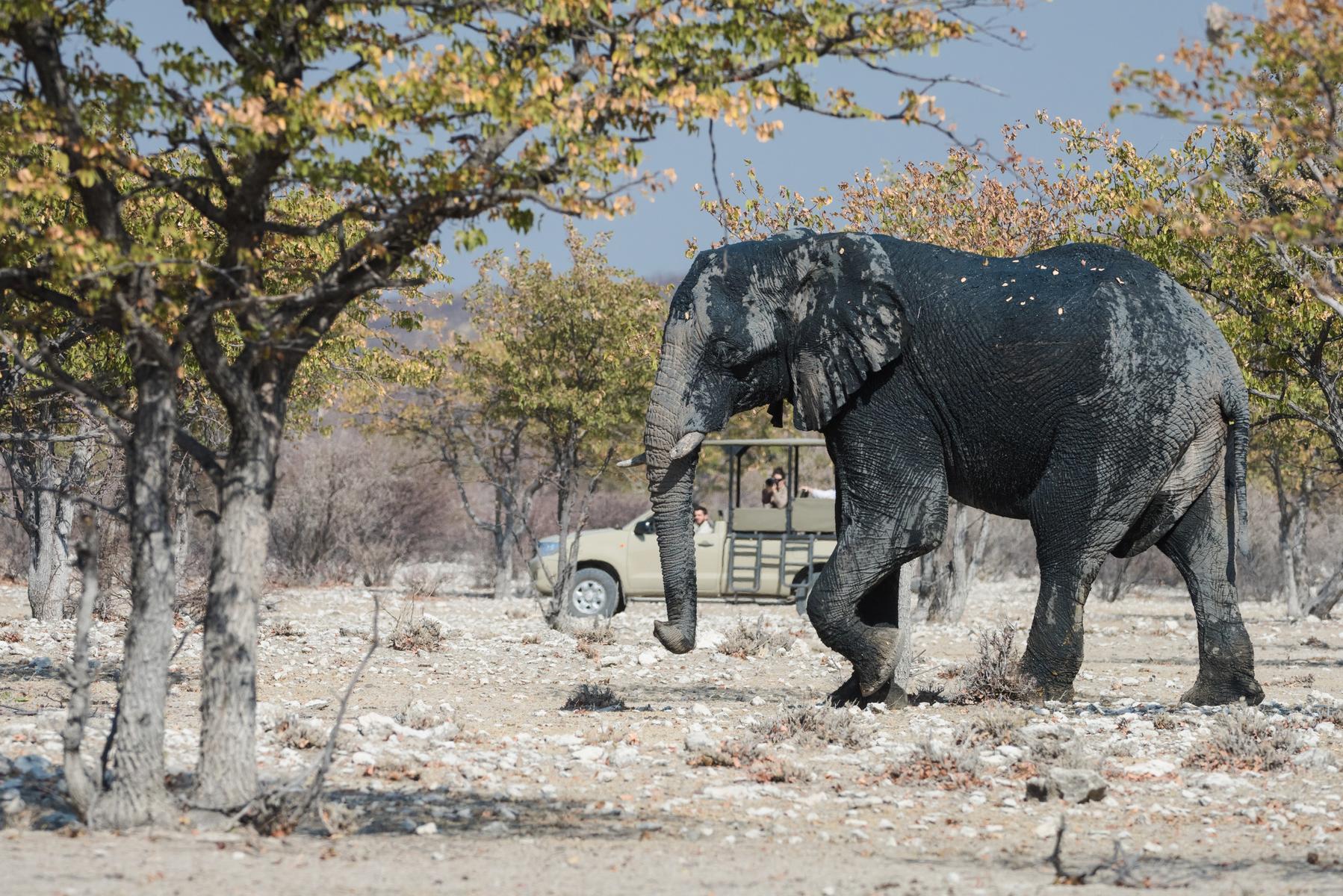
Namibia’s unique desert-adapted wildlife, including lions, elephants, black rhinos, giraffes, springbok, oryx, and beetles, have adaptations to survive extreme heat and water scarcity.
Some desert lions hunt seals on the coast and drag their prey inland. They cover immense distances of up to 2,000 km² in search of food and water, an essential survival strategy in the desert.
Desert elephants also travel vast distances and have broader feet than savannah elephants to move across sand. They dig “elephant wells” up to a metre deep in dry riverbeds, accessing vital underground water.
Oryxes and some foxes have intricate networks of veins in their ears to cool their blood before it reaches their brains, preventing overheating.
Desert succulents and lichens in this seemingly barren landscape include welwitschia, which have been carbon-dated to over 1,000 years old, some even older than 2,000 years.
Botswana vs Namibia Safari Comparison
The comparison of Namibia vs Botswana safaris is a frequent question for travellers. Namibia’s stark desert contrasts with Botswana’s lush waterways, offering two very different but equally unforgettable African safari experiences.
| Namibia | Botswana | |
| Landscape | Stark, dramatic desert and geological landscapes: towering red dunes of Sossusvlei, Namib Desert (the world's oldest), Etosha National Park’s salt pan, eerie Skeleton Coast, rocky mountains of Damaraland | Water-rich ecosystems: Okavango Delta (lush waterways, islands, channels), Chobe River, vast grasslands. Also features the huge, dry Makgadikgadi Pans and the Kalahari Desert |
| Top safari destinations | Etosha National Park, Namib-Naukluft National Park, Erindi Private Game Reserve, Zambezi Region Caprivi Strip, Skeleton Coast National Park | Okavango Delta (Moremi Game Reserve), Chobe National Park, Central Kalahari Game Reserve, Makgadikgadi Pans National Park |
| What to do | Adventure activities: hot air ballooning over the desert, quad biking, horse riding safaris, dune climbing, sandboarding. Big Five safaris, traditional game drives, walking safaris, cheetah tracking. Unique viewing: shipwrecks on the Skeleton Coast, ancient rock art in Damaraland | Water-based: mokoro (traditional canoe) excursions, boat safaris in the Okavango Delta and Chobe River. Big Five safaris, traditional game drives, walking safaris, fly-in safaris (due to remote lodges). Focus on high-end, exclusive experiences |
| Wildlife | More dispersed wildlife because of arid environment, but unique desert-adapted species like elephants, lions, and black rhinos. Etosha offers excellent viewing, as animals congregate at waterholes. Big Five, gemsbok (oryx), springbok, bat-eared foxes, Namaqua chameleon, cheetah, hippopotamus, giraffe, African wild dog, Damaraland mole-rat, spotted hyena, mountain zebra, meerkat, Cape fur seal | High-density wildlife and abundance in key areas (Okavango Delta, Chobe, Moremi). Largest elephant population in the world (Chobe). Excellent for the Big Five (though rhinos can be rare). Focus on traditional, big-game sightings. Cheetah, hippopotamus, giraffe, African wild dog, spotted hyena, zebra, Nile crocodile |
Best Time to Visit Namibia vs Botswana
Choosing the best time to visit Namibia vs Botswana depends on what kind of safari you want. Namibia shines for desert adventures in the dry season, while Botswana’s Okavango Delta is magical during its flood season.
| Namibia | Botswana | |
| Peak Season | July to October: Ideal for wildlife viewing (animals at waterholes, thinner vegetation). Cooler temperatures for desert exploration | June to October: Peak for wildlife viewing as animals congregate around water sources. Also, the Okavango Delta is often at its fullest from the Angolan rains, creating a lush environment |
| Rainy season | November to April | November to March |
| Dry season | May to October | April to October |
During the dry winter months, there’s less vegetation, making it easier to spot wildlife in the bush. Animals congregate around water sources, making for excellent game-viewing at waterholes and rivers.
Nowhere is this more spectacular than in Botswana’s Okavango Delta. During the dry season, rain is scarce, but the region transforms into a vast wetland as water flows in from sources far north in Angola. Herbivores thrive on the abundant vegetation, while predators take full advantage. Remarkably, lions here have adapted to navigate crocodile- and hippo-infested waterways to hunt their prey.
In Namibia, the Etosha National Park offers incredible wildlife viewing during the dry winter season, as animals flock to its famous salt pans and waterholes. Temperatures are also cooler and can be more comfortable. Namibia’s desert landscapes, including the Sossusvlei dunes and Skeleton Coast, provide a stark but stunning contrast to its wildlife regions.
Cost
| Namibia | Botswana | |
| Cost differences | Generally more budget-friendly, and prices for guided tours are lower than Botswana's luxury market, though there are also exclusive, luxe offerings | Generally more expensive. Known for a high-value, low-impact tourism model, resulting in exclusive, high-end, luxury safari experiences. Fly-in safaris to remote lodges add significant cost |
Safari Planning Guide
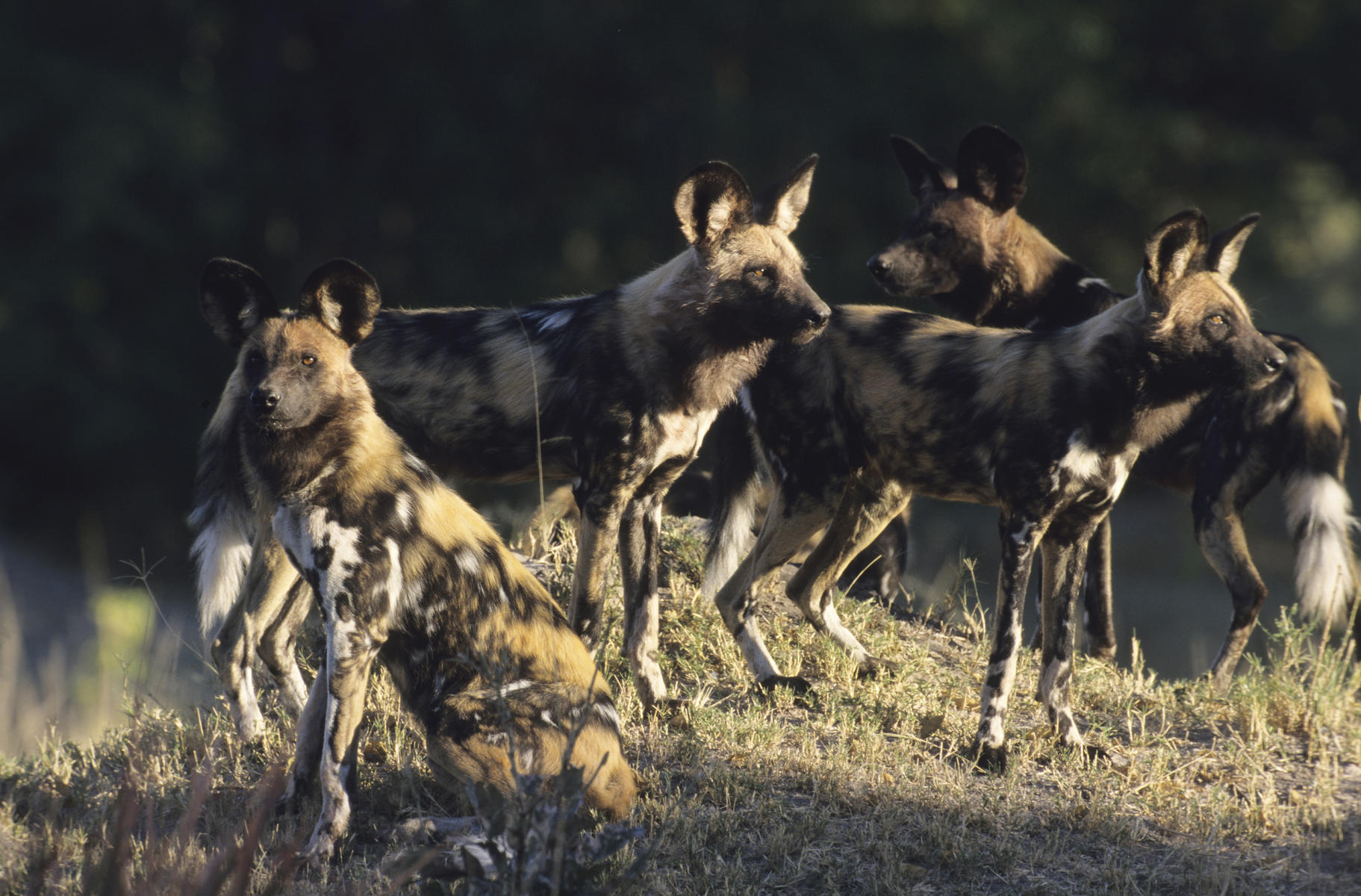
You can see all of the Big Five in Namibia, but not all in the same place. Etosha National Park has elephants, rhinos, lions, and leopards, but not buffaloes. Buffaloes can be seen in the Zambezi Region. That makes Botswana the clear winner for Big Five safaris (although rhinos are challenging to see).
Botswana has the world’s largest population of elephants, but Namibia has its desert-adapted pachyderms and famous white-grey ghost elephants of Etosha. You can see lions, leopards, and cheetahs in both Namibia and Botswana.
Namibia is famous for its desert-adapted lions, while Botswana’s Okavango Delta has thriving populations of both lions and leopards.
Namibia also has one of the largest populations of cheetahs that live outside of protected areas, thanks to various conservation initiatives based around the country.
For birdwatching, the Okavango Delta is the undisputed winner. The seasonal floods attract immense numbers of birds from as far afield as Siberia, and the abundance of local species like eagles, vultures, and colourful bee-eaters makes it a bird photographer’s dream. A bit further south, flamingos and other waders fill the brackish waters of the Makgadikgadi Pans.
| Namibia | Botswana | Both Regions | |
| Activities | Desert safaris, hot air balloon safaris, culture safaris, remote safaris | Birdwatching safaris, horse riding safaris, mobile camping safaris, mokoro safaris, zebra migration safaris | Photographic safaris, Big Five safaris |
Choosing Your Destination
Botswana and Namibia are strong safari destinations in their own right, each offering exceptional wildlife, remote and rugged landscapes, and luxury experiences.
Neighbours, they are also very different. For a more exclusive safari adventure, Botswana; for a more dramatic safari adventure, Namibia.
Booking Your Safari
It’s a tough choice between Botswana’s waterways and Namibia’s deserts. If you’re ready to move from comparing to crafting, browse our pre-built packages or let us build a custom trip just for you.






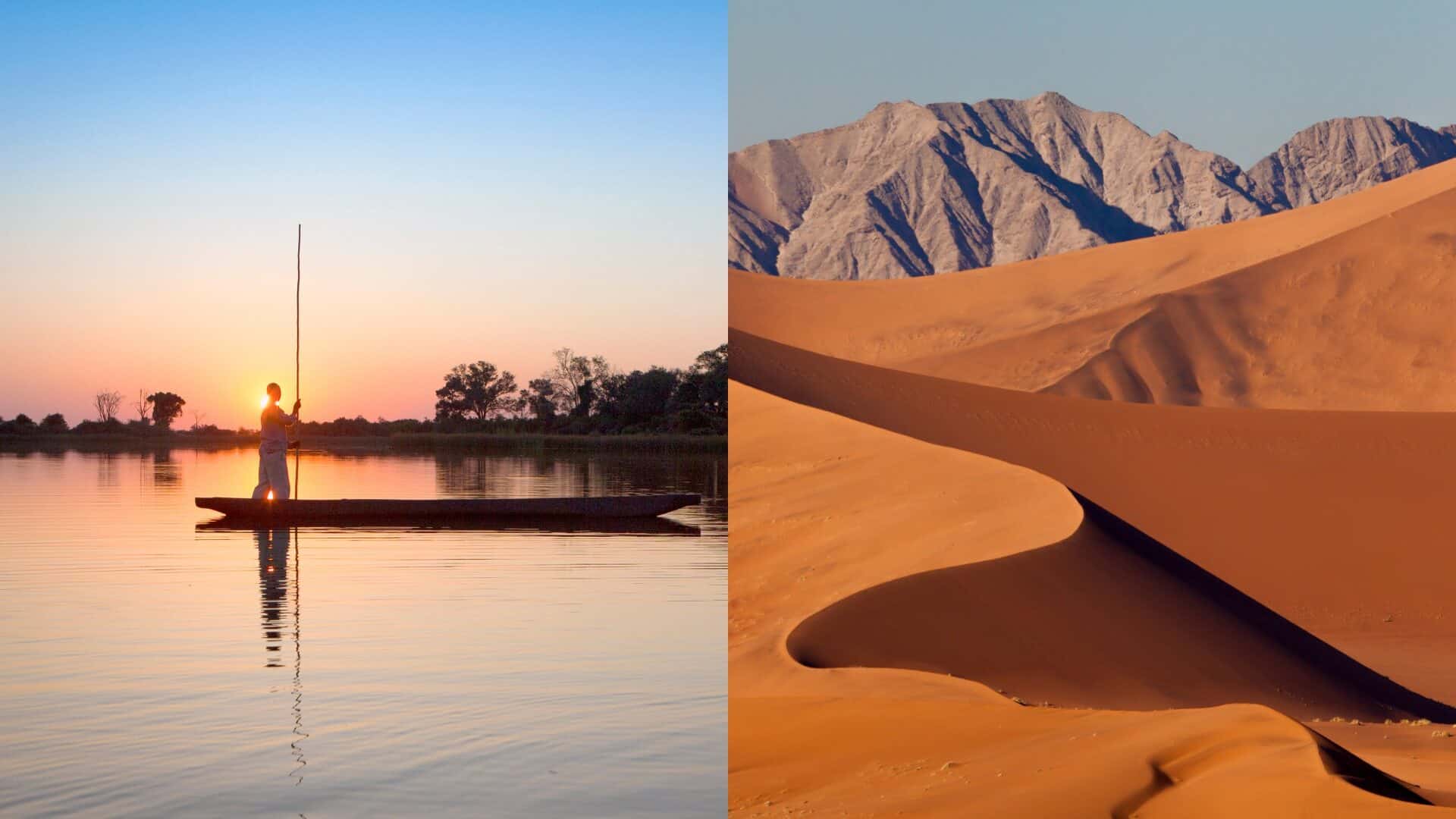



 Copy Link
Copy Link
 Share on LinkedIn
Share on LinkedIn
 Share on Facebook
Share on Facebook











